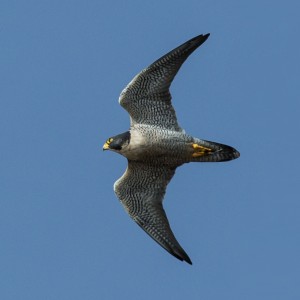 Peregrine Falcon (Falco peregrinus) observation birding Valencia
Peregrine Falcon (Falco peregrinus) observation birding Valencia
The peregrine falcon -size 15 ½ -19 ¾ inches, wingspan 37 ½ -45 ¼ inches- is a well known and appealing species. One of the main reasons for this is that it is the fastest bird in the world. Although there is an ongoing debate about their actual top speed, experts do agree that it exceeds 200 kilometres an hour. The peregrine falcon is the most widely occurring large falcon in Europe, recognisable by the slate grey top, light throat and chest area, and with narrow banding on the rest of the trunk and wings.
Birding Valencia; The black beard area under the eye is characteristic of this species and when observed closely the yellow ring around the eyes is visible. In flight the peregrine is recognised by the stocky body and pointed wings, which beat shallow and is slightly stiff looking. An interesting fact is that females are much larger than the males, and the difference is very clear when observed together. Peregrines catch their prey, which are almost exclusively medium-sized birds such as pigeons, by means of a dive at high speed. The power that is released by the collision causes unconsciousness or sudden death in the prey species, which are then often transported to a favourable open eating spot with good views. Peregrines live in many different habitats around the world, in areas that provide enough prey and plenty of open space for hunting purposes. Peregrines are more choosy when it comes to picking a suitable breeding site, often preferring steep rock walls.
Spain is home to around 25 % of the estimated 10,000 breeding pairs in Europe because of the many mountainous and rocky areas of the Iberian Peninsula . The rocky outcrop behind Refugio Marnes is most likely the territory to a Peregrine Falcon often seen flying alongside the cliffs. Peregrines are resident birds in areas where winters are mild, such as the Costa Blanca.





